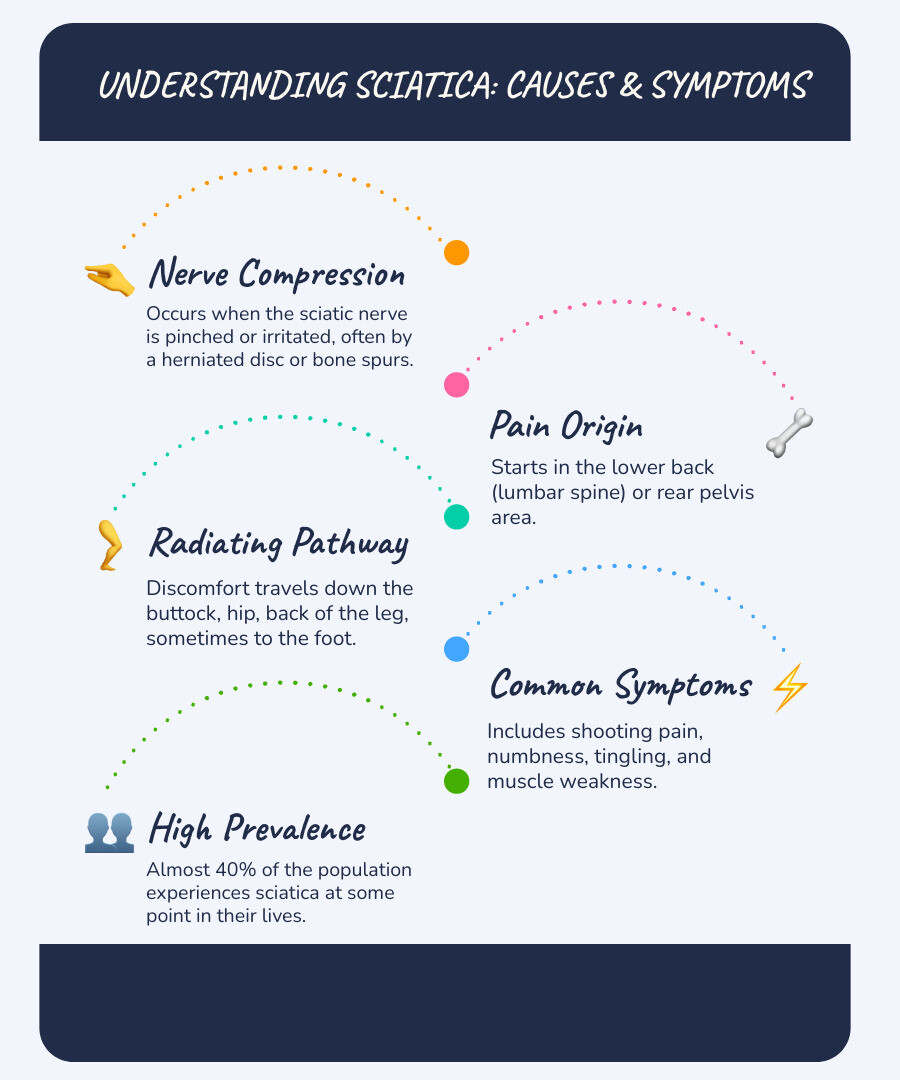Why Finding the Right Cream Matters for Sciatica Relief
Using the Best Cream for Sciatica Pain can provide fast, targeted relief without the systemic side effects of oral medications. If you're experiencing shooting pain from your lower back down your leg, you're not alone—up to 40% of people experience sciatica in their lifetime. The good news is that topical creams offer a practical, accessible solution for managing this debilitating nerve pain.
Quick Answer: Top Ingredients to Look For
| Ingredient | How It Helps |
|---|---|
| Menthol | Creates a cooling sensation that distracts from pain signals |
| Arnica | Reduces inflammation and improves blood circulation |
| Aloe Vera | Soothes skin and provides anti-inflammatory benefits |
| Urea | Improves absorption and hydrates skin |
| Capsaicin | Desensitizes nerve receptors to block pain signals |
Sciatica occurs when the sciatic nerve becomes compressed or irritated, often by a herniated disc or bone spurs. This causes pain to radiate from your lower back down your leg. While the location makes it challenging to treat, topical creams can target the source of discomfort with minimal risk.
Unlike oral painkillers that circulate through your entire system, topical treatments work locally. According to Harvard Health, topical medications are generally very safe, with rare systemic side effects and occasional minor skin reactions that resolve quickly.
I'm Tony Enrico, and I've dedicated my career to helping people manage nerve and muscle pain with natural solutions like our Best Cream for Sciatica Pain at Neuropasil. Our advanced formula combines menthol, aloe, urea, and other natural ingredients to deliver fast-acting relief that gets you back to doing what you love.

How Topical Creams Provide Sciatica Relief
When sciatica pain strikes, a Best Cream for Sciatica Pain can offer fast, targeted relief. But how does rubbing a cream on your skin ease nerve pain that originates deep in your spine?
The secret is topical application. Unlike oral medications that must pass through your digestive system, creams deliver active ingredients directly to the source of pain—your lower back, hip, or leg. This localized approach means fewer systemic side effects. According to Harvard Health, topical medications are generally very safe, with only rare instances of minor skin reactions that typically resolve quickly.
Many effective creams work in two key ways:
- As a Counter-Irritant: Ingredients like menthol create a cooling sensation on the skin. This new sensation travels to your brain, effectively distracting it from the deeper sciatic pain. It’s a process of pain signal confusion, where the cooling feeling overrides the pain signals.
- As an Anti-Inflammatory: Other ingredients work to reduce the inflammation that may be compressing your sciatic nerve. By calming the irritated nerve and surrounding tissues, these creams address a root cause of the discomfort, not just the symptoms.
Some ingredients, like capsaicin (from chili peppers), work by desensitizing nerve receptors over time. Initially, it creates a warming sensation, but with repeated use, it depletes a chemical that sends pain messages to your brain, providing lasting relief.
By combining these mechanisms, sciatica creams offer a multi-pronged attack on pain and inflammation, all without putting medication through your entire system. For a comprehensive look at how different ingredients work, check out The Complete Guide to Nerve Pain Relief Creams.
Key Ingredients to Look for in a Sciatica Pain Relief Cream
When searching for the Best Cream for Sciatica Pain, the ingredient list is your most important guide. The most effective formulas combine several ingredients that work together to soothe irritated nerves, reduce inflammation, and calm pain signals.

Here are some of the top ingredients to look for:
Counter-Irritants
These ingredients create a mild cooling or warming sensation on the skin that distracts your nervous system from the deeper sciatic pain.
- Menthol: This is a leading counter-irritant that provides a refreshing cooling sensation. It activates cold-sensitive receptors, sending signals to your brain that compete with and override pain signals, offering almost instant relief.
- Capsaicin: Derived from chili peppers, capsaicin creates a warming sensation. With repeated use, it depletes the body's supply of substance P, a neurotransmitter that sends pain signals to the brain, according to clinical research. This desensitizes the nerve endings, leading to long-term pain reduction.
Natural and Herbal Ingredients
Nature provides powerful and gentle solutions for pain relief. These ingredients offer potent anti-inflammatory and analgesic properties.
- Arnica: A centuries-old remedy for inflammation and bruising, arnica is known to improve blood circulation, which helps deliver oxygen and nutrients to damaged tissues and speed recovery.
- MSM (Methylsulfonylmethane): This natural sulfur compound is a powerful anti-inflammatory that supports the health of connective tissues, helping to reduce the swelling that often worsens sciatica pain.
- Aloe Vera: More than just a sunburn remedy, aloe vera has anti-inflammatory properties that help calm irritated tissues and soothe the skin.
- Urea: This ingredient plays a crucial supporting role. It improves the skin's ability to absorb other active ingredients, acting as a penetration enhancer to ensure they can penetrate deeply to where they are needed most.
At Neuropasil, our formula harnesses the synergistic power of these natural ingredients. You can discover the power of all-natural relief and see how our thoughtful combination of ingredients can make a difference.
Why Neuropasil is the Best Cream for Sciatica Pain in 2024
When you're dealing with sciatica, you need relief that works fast. We created Neuropasil because we understand the frustration of trying over-the-counter options that fail to deliver. Our Best Cream for Sciatica Pain is different because it's built on a thoughtful combination of natural ingredients that target nerve and muscle pain at its source.
What sets our cream apart is a formula refined over years of listening to customer feedback. The result is a cream that provides fast-acting relief—often within minutes—without the greasy residue or harsh chemical smell common in other topical treatments. It absorbs quickly, penetrating deep to soothe irritated nerves while leaving your skin feeling clean and comfortable.
We believe in transparency, which is why we're proud of our natural ingredient list. No mystery chemicals or artificial fragrances—just proven, effective compounds that provide genuine relief.
Neuropasil Nerve Pain Relief Cream: The Natural Formula for Sciatica
Our Nerve Pain Relief Cream is the natural choice for sciatica sufferers because of three powerhouse ingredients that work in perfect harmony.
- Aloe Vera: This forms the soothing foundation of our formula, offering powerful anti-inflammatory properties to calm irritated tissues and reduce swelling around compressed nerves.
- Urea: This is the key to our formula's effectiveness. It improves how well the active ingredients penetrate your skin, ensuring maximum relief gets delivered right where you need it most.
- Menthol: This provides the signature cooling sensation that you can feel working almost instantly. The refreshing wave of relief helps override pain signals and relax tense muscles.
Together, these natural ingredients create a non-greasy cream that absorbs quickly, so you can apply it and get on with your day. It's gentle enough for daily use, even on sensitive skin.
Key Benefits of Neuropasil for Sciatica
- Fast-acting relief for nerve and muscle pain
- Combines menthol, aloe vera, and urea for a soothing effect
- Non-greasy, easy to apply, and absorbs quickly
- Free from harsh chemicals and artificial fragrances
- Suitable for daily use and sensitive skin
Real User Experiences
The stories from our customers say it all. People dealing with everything from sciatica and neuropathy to fibromyalgia and athletic soreness have found real relief with Neuropasil.
We consistently hear from users who can finally sleep through the night without pain and spasms or are able to walk and perform daily activities again. These aren't just isolated testimonials; they represent a pattern of success for people getting back to their lives—playing with grandkids, running, or simply getting through a workday without debilitating pain.
We invite you to read more of these genuine stories on our Customer reviews page. Their experiences speak louder than any marketing campaign ever could.
Maximizing Relief: How to Use Sciatica Creams Effectively
Finding the Best Cream for Sciatica Pain is the first step. Using it correctly is how you open up its full potential. Think of your cream as a powerful tool that works even better as part of a broader pain management strategy.
Proper Application for Sciatica
Sciatica pain may shoot down your leg, but the problem usually originates from nerve roots in your lower back. To treat the source, not just the symptoms, follow these steps.

- Target the Origin: Apply the cream to your clean, dry skin on your lower back and rear pelvis, right behind your hip.
- Massage Thoroughly: Use a sufficient amount of cream and massage it into the skin with firm, circular motions. This helps with absorption and relaxes tight muscles.
- Stay Safe: Always wash your hands with soap and water after application to avoid getting ingredients like menthol in your eyes. Never apply cream to broken or irritated skin.
For more tips, see our guide on Sciatica Solutions: Simple Steps to Soothe Nerve Pain at Home.
Combining Creams with Other Therapies
While Neuropasil provides significant relief on its own, combining it with other therapies can accelerate your healing.
- Physical Therapy: A therapist can design exercises to strengthen your back. Applying cream before sessions can make movements more comfortable, and using it after can aid muscle recovery.
- Gentle Stretching: Movement is key. Applying cream before you stretch can ease discomfort and help you maintain flexibility.
- Hot and Cold Therapy: A cold pack can reduce acute inflammation, while a warm compress can relax muscles. Apply the pack first, wait for your skin to return to a normal temperature, and then apply your cream. Never use a heating pad and a counter-irritant cream at the same time.
- Doctor Consultation: Creams offer temporary relief, but a doctor can diagnose underlying issues like a herniated disc. Research shows that combining treatments is often effective for successful sciatica management.
When to See a Doctor for Sciatica Pain
While creams like Neuropasil offer excellent temporary relief, they don't fix the underlying cause of sciatica. It's crucial to listen to your body and know when it's time to seek professional medical help.
According to medical experts like those at the Cleveland Clinic, you should make an appointment with your doctor if you experience any of the following:
Severe or Worsening Pain: If the pain is debilitating, getting worse, or doesn't improve after a week of home care, it's time for a medical evaluation.
Muscle Weakness: If you have trouble lifting your foot (foot drop), your leg feels like it's giving out, or you're tripping often, this could signal significant nerve compression.
Numbness in the Groin or Inner Thigh: This, along with any new difficulty with bladder or bowel control, can be a sign of a rare but serious condition called cauda equina syndrome. This is a medical emergency that requires immediate attention.
Pain After a Traumatic Injury: If your sciatica began after a fall or car accident, see a doctor to rule out a fracture or other structural damage.
Persistent Symptoms: Even if your symptoms aren't severe, it's worth getting checked out if they last for more than a few weeks.
A doctor can determine the exact cause of your pain, potentially with imaging tests like an MRI, and recommend a comprehensive treatment plan. As medical experts note, alleviating pressure on the sciatic nerve is the best way to treat sciatica, which may require professional intervention.
For more guidance, read our article When Sciatica Strikes. Using the Best Cream for Sciatica Pain is a key part of your toolkit, but knowing when to get help is vital for your long-term health.
Frequently Asked Questions about Sciatica Creams
We get a lot of questions from customers about managing sciatica pain. Here are answers to some of the most common ones.
Is Advil or Tylenol better for sciatica?
For sciatica, ibuprofen (Advil) is generally the better choice. Ibuprofen is a non-steroidal anti-inflammatory drug (NSAID), meaning it reduces both pain and the inflammation that is often the root cause of sciatica. According to Cleveland Clinic, ibuprofen is a better choice for sciatica for this reason. Acetaminophen (Tylenol) reduces pain but does not target inflammation. If you cannot take NSAIDs, acetaminophen is an alternative for pain relief, but always consult your doctor or pharmacist first.
How long does a typical sciatica flare-up last?
This varies greatly, but most acute sciatica flare-ups resolve within one to two weeks, though symptoms can last longer. The duration depends on the cause and severity of the nerve compression. While creams like our Best Cream for Sciatica Pain provide immediate relief, consistent use over several weeks may be needed for lasting improvement as your body heals. If your pain isn't improving after a couple of weeks, it's time to see a doctor.
Can I use a heating pad with a pain relief cream?
No, you should not use a heating pad at the same time as a pain relief cream, especially one containing counter-irritants like menthol or capsaicin. The combination can intensify the cream's effect and lead to skin irritation or even burns. Always check the product label for warnings. If you want to use both heat and a cream, stagger them: apply the heat pack first, wait for your skin to cool to its normal temperature, and then apply the cream. When in doubt, ask your pharmacist.
Conclusion
Navigating sciatica is challenging, but finding the Best Cream for Sciatica Pain is a major step toward reclaiming your comfort. Topical creams offer a targeted, effective approach with fewer systemic side effects than oral pills. By using key ingredients like menthol, aloe vera, and urea, they work to soothe inflammation and quiet the irritated sciatic nerve.
Our Neuropasil Nerve Pain Relief Cream harnesses these natural components in a non-greasy, fast-absorbing formula that our users trust for rapid relief. For the best results, apply it directly to the source of the pain in your lower back and combine it with other therapies like gentle stretching.
While creams are an invaluable tool for managing pain, it's important to see a doctor for severe or persistent symptoms. We encourage you to take a proactive step towards comfort and Say Goodbye to Sciatica: The Best Creams to Soothe Your Nerves. Your well-being is our top priority.
References
- Sciatica - StatPearls - NCBI Bookshelf. National Center for Biotechnology Information. (Cited for sciatica prevalence.)
- What should you do when sciatica flares? - Harvard Health. Harvard Medical School. (Cited for topical medication safety and flare-up duration.)
- Capsaicin - StatPearls - NCBI Bookshelf. National Center for Biotechnology Information. (Cited for capsaicin's mechanism of action.)
- A Review of the Pharmacological Efficacy of Aloe Vera. Phytotherapy Research. (Cited for aloe vera's anti-inflammatory properties.)
- Arnica - American Pharmacists Association. Pharmacy Today. (Cited for arnica's properties.)
- Methylsulfonylmethane: Applications and Safety of a Novel Dietary Supplement. Nutrients. (Cited for MSM's anti-inflammatory properties.)
- Urea as a Topical Agent: A Review. Dermatology and Therapy. (Cited for urea's role as a penetration enhancer.)
- Medication for Sciatica. Spine-health. (Cited for the effectiveness of combined treatments.)
- Sciatica: Causes, Symptoms, Treatment, Prevention & Pain Relief. Cleveland Clinic. (Cited for ibuprofen's effectiveness and when to see a doctor.)
- Ibuprofen: MedlinePlus Drug Information. MedlinePlus. (Cited for information on ibuprofen.)















